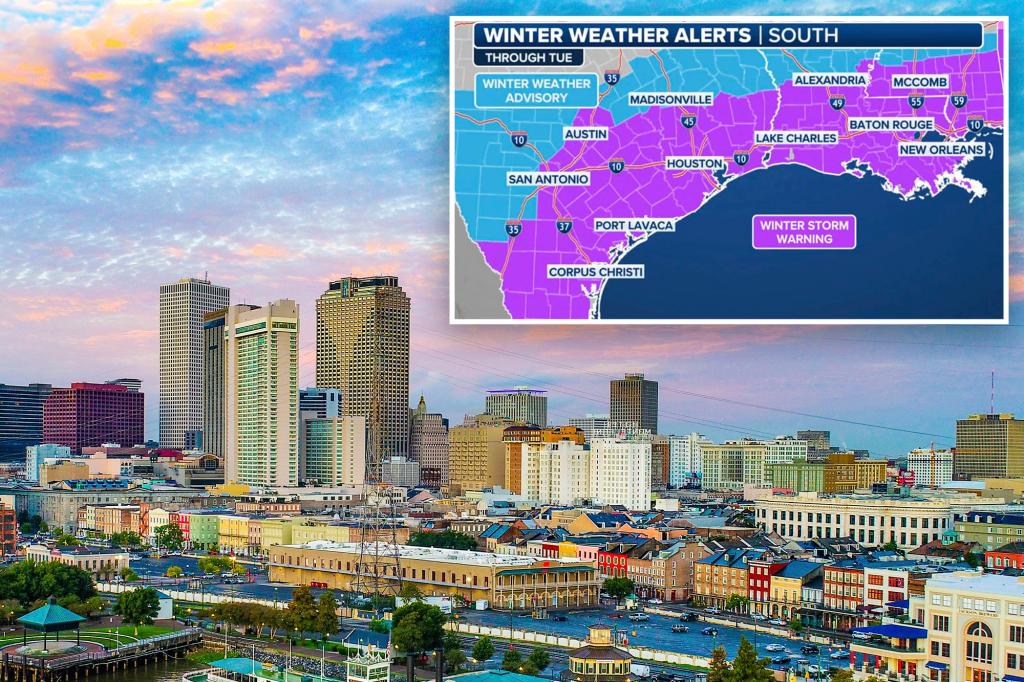A massive winter storm, unprecedented in its scope and intensity for the Gulf Coast region, is poised to unleash heavy snowfall, ice, and frigid temperatures, affecting an estimated 55 million people from Texas to Florida. Cities typically associated with balmy weather, such as Houston, Baton Rouge, and New Orleans, are bracing for an unusual onslaught of winter precipitation, with forecasts predicting up to six inches of snow in some areas. This rare event has triggered preemptive states of emergency in Florida and Louisiana, as officials scramble to prepare for the potential disruptions and hazards. The storm’s impact is expected to ripple across the region through midweek, bringing a stark contrast to the usual mild winter conditions experienced along the Gulf Coast.
The severity of the impending storm has prompted urgent calls for residents to prioritize safety and minimize travel. Governors and state officials are urging people to stay off the roads unless absolutely necessary, emphasizing the importance of staying home and warm. The unusual nature of this weather event poses significant challenges for a region not typically equipped to handle heavy snowfall. Louisiana, for example, has amassed 400,000 pounds of salt to combat icy roads and bridges, while also preparing contingency plans for potential road closures. The strain on infrastructure and resources highlights the exceptional nature of this storm and the need for proactive measures to mitigate its impact.
Beyond the immediate threat of heavy snow and ice, the storm carries with it the danger of plummeting temperatures, potentially breaking historical records in several states. Freezing temperatures, expected to persist for extended periods, could wreak havoc on infrastructure, leading to burst pipes, cracked roads, and widespread power outages. The unusual duration of the sub-freezing conditions poses a particular threat to vulnerable populations, emphasizing the need for community preparedness and support. The impending cold snap could see temperatures plunge 20 to 40 degrees below average, creating a dangerous chill across a vast swathe of the southern United States.
The far-reaching implications of this storm extend beyond the immediate Gulf Coast region. As the primary system moves northward, it is expected to bring freezing rain to coastal areas of Georgia, South Carolina, and North Carolina, further expanding the area affected by wintry precipitation. Even after the main storm passes, a second wave of snow and heavy rain is forecast to hit the Florida Peninsula later in the week, prolonging the period of disruptive weather. The cumulative effect of these successive weather systems underscores the widespread nature of this winter event and its potential for prolonged disruption.
Adding to the complexity of the situation, the Gulf Coast region is generally ill-equipped to handle significant snowfall. Unlike northern states accustomed to regular winter storms, cities along the Gulf Coast lack the infrastructure, equipment, and experience to effectively manage heavy snow accumulation. This vulnerability necessitates proactive measures to minimize disruptions and ensure public safety. The combination of heavy snow, ice, and extreme cold presents a unique set of challenges for a region accustomed to milder winter conditions.
The sheer scale of this winter storm is staggering, with weather alerts extending to 214 million people from the southern tip of Texas to central Florida. While 55 million are directly in the path of the heaviest snowfall and ice, the vast majority of the southern US is bracing for a period of unusually cold temperatures. This widespread impact highlights the exceptional nature of this weather event and underscores the importance of preparedness and vigilance. The potential for widespread power outages, transportation disruptions, and other emergencies requires a coordinated response from individuals, communities, and government agencies.

